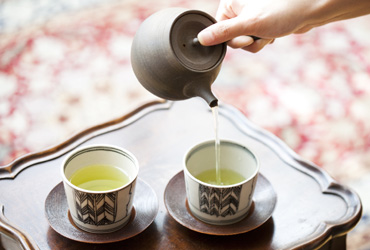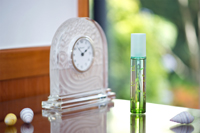Web Japan > Trends in Japan > Tech & Life > Green Tea
Green Tea
A Centuries-Old Japanese Drink for Healthy Life
Green tea has been closely associated with Japanese people for such a long time that it is now known as "Japanese tea." Green tea is more than just a drink. It is a custom that is woven into the fabric of Japanese life.
Sencha, the Quintessential Green TeaJapanese green tea is produced in its own unique way, with the tealeaves steamed to stop fermentation. Depending on how the tealeaves were cultivated, their position on the plant, the amount of time they were allowed to steam, and how they were dried and processed, green tealeaves are classified as sencha, matcha, gyokuro, kukicha, or any number of other varieties.
Sencha is produced by picking only the youngest tealeaves, which are then steamed and crumpled as they are dried. This method was invented in the early 18th century, and sencha has been the mainstream green tea in Japan ever since that time. In fact, sencha accounts for the majority of green tea consumed in Japan today.
Everyday Life with Green TeaGreen tea is the drink of choice in the morning after waking, as a break in the afternoon, or served to guests in a show of hospitality. Several times a day, most Japanese people will take the time to fill a small teapot with tealeaves, pour in the hot water, and let the tea brew for a while. Green tea is even taken outdoors to picnics and enjoyed during breaks at the office from a flask or thermos.
In restaurants, tea is provided free of charge as soon as diners are seated, and refills are provided as often as requested. Tea is actually an essential part of any meal. The taste of green tea combines a refreshing bitterness and astringency with just a hint of sweetness, making it the perfect compliment to any type of food. Green tea is also a great palette cleanser for refreshing the mouth after a meal of fatty foods or raw food like sushi.
Today, bottled green tea has become increasingly popular for the ease and convenience of drinking it. Vending machines and convenience stores are stocked so full of green tea varieties in different tastes and aromas that choosing just one becomes difficult. Sugar is not usually added to green tea in Japan. Many Japanese people drink it habitually in the way people in other countries drink water, and many people now opt to drink it as a health drink.

|

|

|
| Green tea enjoyed outdoors from flasks and thermoses (left photo, AFLO), or bought in plastic bottles (at right) | Bottled green tea stocked next to sodas and sports drinks on convenience store shelves | |
Belief in the Power of TeaIntroduced from China in the beginning of the 9th century, tea was lauded as an elixir to bring perpetual youth and longevity and valued for quite a long time for its medicinal properties more than for the pleasure of its taste. Japanese people have turned to tea when they were not feeling well and gargled with salted tea when they catch a cold. As expressed in the proverb, "Morning tea brings good fortune," the idea that that a cup of tea in the morning staves off misfortune, tea was at one time revered almost as an object of veneration.
Properties in Green Tea Make Life RicherContaining five times as much Vitamin C as a lemon, green tea is said to boost the blood vessels and circulatory system and stave off germs. It is this Vitamin C that is the main reason that green tea has long been thought of in Japan as an effective means of fighting off colds.
Catechin is what gives green tea its bitterness and astringency, and it can be extracted most effectively when brewing the tealeaves with boiling water heated to 90ºC for a short time. A powerful anti-oxidant, catechin is said to keep cells from aging and help prevent high blood pressure and diabetes. Catechin has been introduced as an ingredient in many food products and supplements and has also been a hit in many products marketed for antibacterial or odor-resistant properties such as towels, underwear and gum to prevent bad breath.
Green tea extract is now a popular fragrance in aromatherapy, as well. Used in products such as eau de parfum or incenses, its fresh, clean, sweet scent is entirely different from any fragrance previously known, providing an exquisitely Japanese aromatic sense.
With its special properties for keeping people healthy and keeping cells from aging, green tea has become a dependable, therapeutic part of life in Japan. Green tea, indeed, is one key to the healthy lifestyles and long life of people in Japan.
(December 2011)
- Zeroing in on the Health Boom (January 2009)
- Vinegar Vitality (August 2006)




